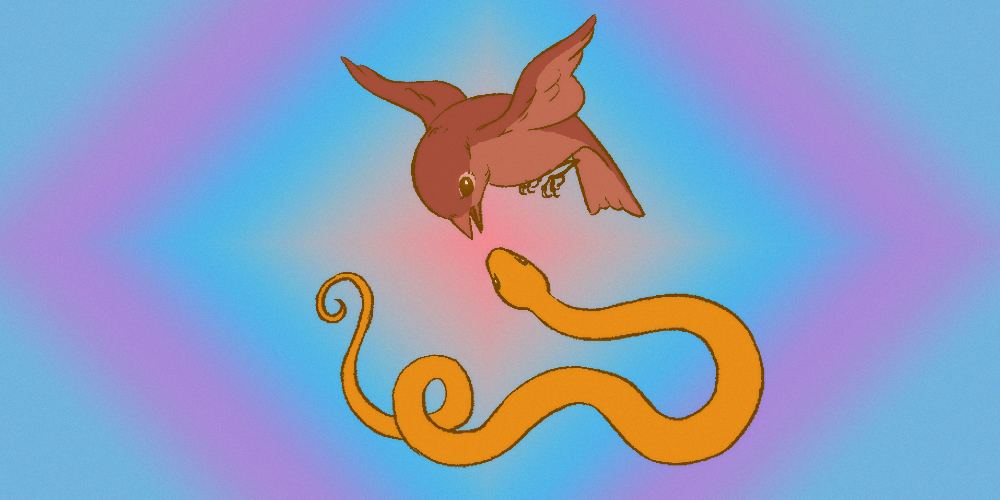The Ballad of Songbirds and Snakes, Suzanne Collins’s novel whose 2020 debut was followed up by its cinematic release last month, brings the audience back to Panem, back to the wilderness of District 12, back to an arena where 24 unlucky children encircle a cornucopia of weapons as an announcer counts down to their deaths. Except this time, we aren’t viewing a fully formed Hunger Games, with its scenic arena and black athleisure uniform; it’s the 10th annual Hunger Games, which takes place in an empty football stadium, the turnstiles at the entryway calling out “enjoy the show” while the tributes walkthrough. And, most notably, this story does not consist of a love triangle between an arrow-slinging survivor, the baker’s son, and a jealous childhood friend — instead, we’re introduced to an entirely new cast. The only names that ring bells are that of Lucky Flickerman (Jason Schwartzman), presumably the ancestor to famous host Caesar Flickerman, who is apparently a nepo baby; Tigris (Hunter Schaefer), a stylish designer in the Capitol in The Hunger Games and a struggling fashion student in Songbirds and Snakes; and, of course, Coriolanus Snow (Tom Blyth), whom we first met as the president presiding over Panem but is now just an 18-year-old desperate to win a scholarship to university and reinstate his family at the top of Capitol society.
Though young Coriolanus is the protagonist, the character closest to our beloved Katniss Everdeen arrives after the story has started. From the moment Lucy Gray Baird (Rachel Zegler) steps on stage at the Reaping, singing an Appalachian hymn about freedom, it is clear that though she isn’t the main character, she is the character the spotlight is drawn to.
Lucy Gray has similar trappings of characters like Penny Lane, Clementine Kruczynski, or any girl played by Zooey Deschanel; in other words, manic pixie dream girls.

The term was coined by Nathan Rabin in his AV Club article “The Bataan Death March of Whimsy Case File #1: Elizabethtown.” According to Rabin, manic pixie dream girls are “an all-or-nothing-proposition. Audiences either want to marry her instantly (despite The Manic Pixie Dream Girl being, you know, a fictional character) or they want to commit grievous bodily harm against them and their immediate family.” Though the phrase has grown and warped and buckled, it can be used to characterize girls with a few simple attributes: They are 1. love interests in male-dominated stories, 2. outsiders who are also, paradoxically, popular 3. gorgeous, and 4. full of idiosyncrasies and quirks.
In Lucy Gray’s case, check, check, check, and check. A tribute shuttled in from District 12, she is viewed by the Capitol as both a barbarian from the districts and a sweet, charming little girl holding a guitar like it’s a shield. Despite her poverty, she shows up on screen manicured, often decked out in a colorful and corseted dress, once showing off a precise, shimmering green eyeliner wing. She is from the Covey, a nomadic clan of musicians rounded up and stuck in District 12. She speaks with a Southern twang. She sings at immensely inappropriate times: after she is chosen at the Reaping, when surrounded by snakes, or “when I have something to say.”
Lucy Gray is a foil for Katniss: the former lives in the aesthetic, she capitalizes on her charm, she adores attention, while the latter prefers to wear the same side braid every day and must be reminded to wave in a parade. On the surface, they seem antithetical, yet they are bound by striking similarities. In addition to the obvious (their District 12 origin, their singing of “The Hanging Tree,” their weird taste for blond men), both are also fiercely independent and largely uninterested in killing their competitors, even as they are hunted down.
While also contrasting Lucy Gray, Katniss contrasts the epitome of manic pixie dream girlhood. She is a protector well-integrated into district life, the protagonist of her story. Her quirks aren’t ones that typically appeal to men. She is a character that inspires young girls, shows them that power and toughness and obstinacy have as much right in femininity as beauty, maternalism, and gentleness. She has no interest in adventure.
But to write off Lucy Gray is to subscribe to the patriarchal belief that the talents of feminine women are less than because they stereotypically belong to women. She is a different type of girl than Katniss, one we see more often depicted in media, one that could easily be categorized as a manic pixie dream girl (MPDG). But different isn’t synonymous with bad. Katniss was — and still is — so culturally important because she is a young, female protagonist who hunts deer and struggles with vulnerability in a sea of young, female characters who rely on and are at the whim of young men. Lucy Gray can be included in the latter.
Coriolanus serves as Lucy Gray’s mentor for the 10th annual Hunger Games, a practice still so early in its development that there are no fancy feasts to fatten up the tributes or makeover montages pre-presentation. Lucy Gray depends on Coriolanus for food, strategy, and care while she’s locked in a zoo before the Games begin. Her story is reliant on him in Songbirds and Snakes because so is her life. Her manic pixie dreaminess enables her survival.
The most important role of a manic pixie dream girl is what she does in relation to her stable leprechaun brooding boy. It isn’t enough to physically embody an MPDG; it’s imperative to move the plot like one. An MPDG must open the male protagonist’s eyes to a new world, push aside her own goals for him, and further his development. Lucy Gray gives Coriolanus a peek into life outside of the Capitol, she exposes him to new ideas, she shows him a new way to view the Games.
The manic pixie dream girl trope has received a lot of flack, its very naming was spawned by the need to easily reference a tool primarily used and abused by male writers yearning to give the adolescent version of themselves a girl who can teach them adventure. At her very crux, the MPDG is anti-feminist. “Rooted in misogyny, the archetype is used to further men at the expense of women, their choices, and their needs. The dream girl takes on the role of making a man better,” wrote Eryca Worthen in “The Manic Pixie Dream Girl: Who She Is and Everything She Represents.” An MPDG isn’t a person, she’s a plot device.
However, Lucy Gray isn’t your stereotypical manic pixie dream girl; in other words, she’s not your stereotypical stereotype. Lucy Gray is lost, literally, literarily: what is an MPDG doing in a dystopian story? Why aren’t you in the land of comfortable and polished contemporary fiction, where you belong? Or at the very least, magical realism, where the boys can be vampires? Our most culturally relevant dystopian YA heroines — Tris from Divergent, Cassie from The Fifth Wave, and, of course, Katniss from The Hunger Games — are antithetical to manic pixie dream girls. Dystopian YA is a vision of a future that’s so dark, so treacherous, not everyone can survive. Courage and toughness are necessary to stay alive, which is why this genre is overflowing with girls possessing these traits and not the ones seen so often in manic pixie dream girls. They are often shy and cold because their stories depend on their strength, not their likability. The men in their stories are secondary to their survival.
But here is Lucy Gray, an MPDG plopped into a YA dystopian fiction, something so outrageous it parallels a singer being plopped into a fight to the death. Her place in this genre shows how a different kind of girl — for example, a songwriter who lets her long hair hang down her back — can also be brave and strong and tough. Can also survive.
Lucy Gray is a paradoxical manic pixie dream girl: She opens the protagonist’s eyes, she helps him develop. She gives him a taste of life outside the Capitol. She shows him the power of love. She relays the necessity of trust. Yet instead of becoming a more aware, more adventurous version of himself, in this story, the protagonist becomes the villain. It’s not Lucy Gray’s fault that Coriolanus Snow’s psychopathic tendencies and fatal ambition emerged, but she did help them along, unintentionally. What she shows him in the world quickens his descent into depravity.
She is, by definition, a manic pixie dream girl, yet she’s hardly anti-feminist. Her grace and talent and passion are beautiful to behold both in and out of the arena. Even though she is a tool to help Coriolanus become who he is meant to be, she is fully realized. At her side, almost through her, he becomes an apex predator, the peak of masculinity, but she remains unchanged, stuck to her morals. Lucy Gray, the stylish, snake-whispering singer-songwriter from a coal-mining town, has somehow embodied a manic pixie dream girl and become the heroine all at the same time.•




